Xin Wang
Jeff
Imperceptible Jailbreaking against Large Language Models
Oct 06, 2025Abstract:Jailbreaking attacks on the vision modality typically rely on imperceptible adversarial perturbations, whereas attacks on the textual modality are generally assumed to require visible modifications (e.g., non-semantic suffixes). In this paper, we introduce imperceptible jailbreaks that exploit a class of Unicode characters called variation selectors. By appending invisible variation selectors to malicious questions, the jailbreak prompts appear visually identical to original malicious questions on screen, while their tokenization is "secretly" altered. We propose a chain-of-search pipeline to generate such adversarial suffixes to induce harmful responses. Our experiments show that our imperceptible jailbreaks achieve high attack success rates against four aligned LLMs and generalize to prompt injection attacks, all without producing any visible modifications in the written prompt. Our code is available at https://github.com/sail-sg/imperceptible-jailbreaks.
BioBlobs: Differentiable Graph Partitioning for Protein Representation Learning
Oct 02, 2025Abstract:Protein function is driven by coherent substructures which vary in size and topology, yet current protein representation learning models (PRL) distort these signals by relying on rigid substructures such as k-hop and fixed radius neighbourhoods. We introduce BioBlobs, a plug-and-play, fully differentiable module that represents proteins by dynamically partitioning structures into flexibly-sized, non-overlapping substructures ("blobs"). The resulting blobs are quantized into a shared and interpretable codebook, yielding a discrete vocabulary of function-relevant protein substructures used to compute protein embeddings. We show that BioBlobs representations improve the performance of widely used protein encoders such as GVP-GNN across various PRL tasks. Our approach highlights the value of architectures that directly capture function-relevant protein substructures, enabling both improved predictive performance and mechanistic insight into protein function.
MedQ-Bench: Evaluating and Exploring Medical Image Quality Assessment Abilities in MLLMs
Oct 02, 2025Abstract:Medical Image Quality Assessment (IQA) serves as the first-mile safety gate for clinical AI, yet existing approaches remain constrained by scalar, score-based metrics and fail to reflect the descriptive, human-like reasoning process central to expert evaluation. To address this gap, we introduce MedQ-Bench, a comprehensive benchmark that establishes a perception-reasoning paradigm for language-based evaluation of medical image quality with Multi-modal Large Language Models (MLLMs). MedQ-Bench defines two complementary tasks: (1) MedQ-Perception, which probes low-level perceptual capability via human-curated questions on fundamental visual attributes; and (2) MedQ-Reasoning, encompassing both no-reference and comparison reasoning tasks, aligning model evaluation with human-like reasoning on image quality. The benchmark spans five imaging modalities and over forty quality attributes, totaling 2,600 perceptual queries and 708 reasoning assessments, covering diverse image sources including authentic clinical acquisitions, images with simulated degradations via physics-based reconstructions, and AI-generated images. To evaluate reasoning ability, we propose a multi-dimensional judging protocol that assesses model outputs along four complementary axes. We further conduct rigorous human-AI alignment validation by comparing LLM-based judgement with radiologists. Our evaluation of 14 state-of-the-art MLLMs demonstrates that models exhibit preliminary but unstable perceptual and reasoning skills, with insufficient accuracy for reliable clinical use. These findings highlight the need for targeted optimization of MLLMs in medical IQA. We hope that MedQ-Bench will catalyze further exploration and unlock the untapped potential of MLLMs for medical image quality evaluation.
Vulnerable Agent Identification in Large-Scale Multi-Agent Reinforcement Learning
Sep 18, 2025Abstract:Partial agent failure becomes inevitable when systems scale up, making it crucial to identify the subset of agents whose compromise would most severely degrade overall performance. In this paper, we study this Vulnerable Agent Identification (VAI) problem in large-scale multi-agent reinforcement learning (MARL). We frame VAI as a Hierarchical Adversarial Decentralized Mean Field Control (HAD-MFC), where the upper level involves an NP-hard combinatorial task of selecting the most vulnerable agents, and the lower level learns worst-case adversarial policies for these agents using mean-field MARL. The two problems are coupled together, making HAD-MFC difficult to solve. To solve this, we first decouple the hierarchical process by Fenchel-Rockafellar transform, resulting a regularized mean-field Bellman operator for upper level that enables independent learning at each level, thus reducing computational complexity. We then reformulate the upper-level combinatorial problem as a MDP with dense rewards from our regularized mean-field Bellman operator, enabling us to sequentially identify the most vulnerable agents by greedy and RL algorithms. This decomposition provably preserves the optimal solution of the original HAD-MFC. Experiments show our method effectively identifies more vulnerable agents in large-scale MARL and the rule-based system, fooling system into worse failures, and learns a value function that reveals the vulnerability of each agent.
A-TDOM: Active TDOM via On-the-Fly 3DGS
Sep 16, 2025
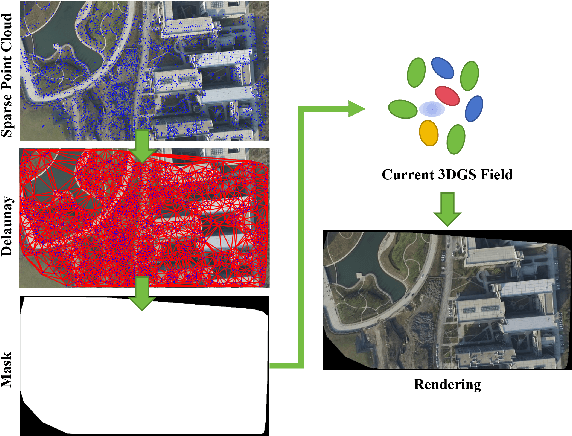
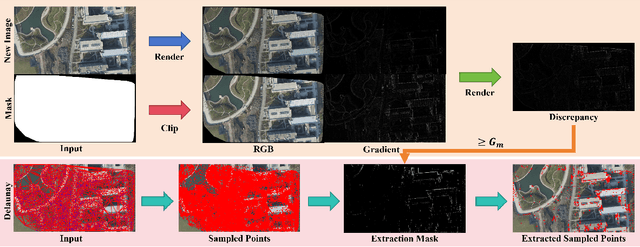
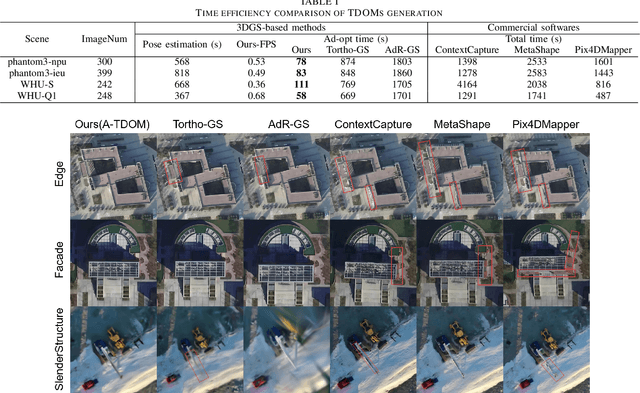
Abstract:True Digital Orthophoto Map (TDOM) serves as a crucial geospatial product in various fields such as urban management, city planning, land surveying, etc. However, traditional TDOM generation methods generally rely on a complex offline photogrammetric pipeline, resulting in delays that hinder real-time applications. Moreover, the quality of TDOM may degrade due to various challenges, such as inaccurate camera poses or Digital Surface Model (DSM) and scene occlusions. To address these challenges, this work introduces A-TDOM, a near real-time TDOM generation method based on On-the-Fly 3DGS optimization. As each image is acquired, its pose and sparse point cloud are computed via On-the-Fly SfM. Then new Gaussians are integrated and optimized into previously unseen or coarsely reconstructed regions. By integrating with orthogonal splatting, A-TDOM can render just after each update of a new 3DGS field. Initial experiments on multiple benchmarks show that the proposed A-TDOM is capable of actively rendering TDOM in near real-time, with 3DGS optimization for each new image in seconds while maintaining acceptable rendering quality and TDOM geometric accuracy.
Data Skeleton Learning: Scalable Active Clustering with Sparse Graph Structures
Sep 10, 2025Abstract:In this work, we focus on the efficiency and scalability of pairwise constraint-based active clustering, crucial for processing large-scale data in applications such as data mining, knowledge annotation, and AI model pre-training. Our goals are threefold: (1) to reduce computational costs for iterative clustering updates; (2) to enhance the impact of user-provided constraints to minimize annotation requirements for precise clustering; and (3) to cut down memory usage in practical deployments. To achieve these aims, we propose a graph-based active clustering algorithm that utilizes two sparse graphs: one for representing relationships between data (our proposed data skeleton) and another for updating this data skeleton. These two graphs work in concert, enabling the refinement of connected subgraphs within the data skeleton to create nested clusters. Our empirical analysis confirms that the proposed algorithm consistently facilitates more accurate clustering with dramatically less input of user-provided constraints, and outperforms its counterparts in terms of computational performance and scalability, while maintaining robustness across various distance metrics.
HealthSLM-Bench: Benchmarking Small Language Models for Mobile and Wearable Healthcare Monitoring
Sep 08, 2025Abstract:Mobile and wearable healthcare monitoring play a vital role in facilitating timely interventions, managing chronic health conditions, and ultimately improving individuals' quality of life. Previous studies on large language models (LLMs) have highlighted their impressive generalization abilities and effectiveness in healthcare prediction tasks. However, most LLM-based healthcare solutions are cloud-based, which raises significant privacy concerns and results in increased memory usage and latency. To address these challenges, there is growing interest in compact models, Small Language Models (SLMs), which are lightweight and designed to run locally and efficiently on mobile and wearable devices. Nevertheless, how well these models perform in healthcare prediction remains largely unexplored. We systematically evaluated SLMs on health prediction tasks using zero-shot, few-shot, and instruction fine-tuning approaches, and deployed the best performing fine-tuned SLMs on mobile devices to evaluate their real-world efficiency and predictive performance in practical healthcare scenarios. Our results show that SLMs can achieve performance comparable to LLMs while offering substantial gains in efficiency and privacy. However, challenges remain, particularly in handling class imbalance and few-shot scenarios. These findings highlight SLMs, though imperfect in their current form, as a promising solution for next-generation, privacy-preserving healthcare monitoring.
Semi-decentralized Federated Time Series Prediction with Client Availability Budgets
Sep 03, 2025Abstract:Federated learning (FL) effectively promotes collaborative training among distributed clients with privacy considerations in the Internet of Things (IoT) scenarios. Despite of data heterogeneity, FL clients may also be constrained by limited energy and availability budgets. Therefore, effective selection of clients participating in training is of vital importance for the convergence of the global model and the balance of client contributions. In this paper, we discuss the performance impact of client availability with time-series data on federated learning. We set up three different scenarios that affect the availability of time-series data and propose FedDeCAB, a novel, semi-decentralized client selection method applying probabilistic rankings of available clients. When a client is disconnected from the server, FedDeCAB allows obtaining partial model parameters from the nearest neighbor clients for joint optimization, improving the performance of offline models and reducing communication overhead. Experiments based on real-world large-scale taxi and vessel trajectory datasets show that FedDeCAB is effective under highly heterogeneous data distribution, limited communication budget, and dynamic client offline or rejoining.
Can Structured Templates Facilitate LLMs in Tackling Harder Tasks? : An Exploration of Scaling Laws by Difficulty
Aug 26, 2025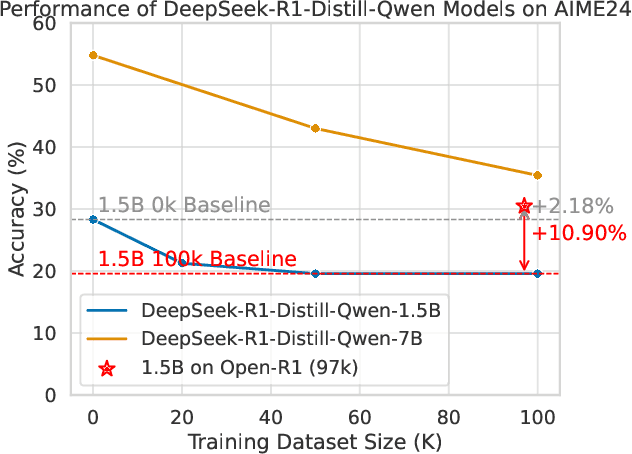

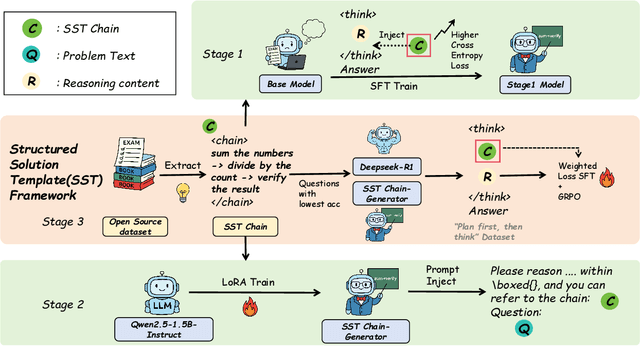

Abstract:Structured, procedural reasoning is essential for Large Language Models (LLMs), especially in mathematics. While post-training methods have improved LLM performance, they still fall short in capturing deep procedural logic on complex tasks. To tackle the issue, in this paper, we first investigate this limitation and uncover a novel finding: a Scaling Law by Difficulty, which reveals that model performance follows a U-shaped curve with respect to training data complexity -- excessive low-difficulty data impedes abstraction, while high-difficulty data significantly enhances reasoning ability. Motivated by this, we propose the Structured Solution Template (SST) framework, which uses solution templates and a curriculum of varied difficulty to explicitly teach procedural reasoning. Specifically, SST comprises (1) fine-tuning with structured solution-template chains and dynamically weighted loss to prioritize procedural logic, (2) prompt-time injection of solution templates as cognitive scaffolds to guide inference, and (3) integrated curriculum fine-tuning that explicitly teaches the model to self-plan - execute - self-correct. Experiments on GSM8K, AIME24, and new Dynamic En benchmark show that SST significantly improves both accuracy and efficiency, especially on harder problems.
Choice Outweighs Effort: Facilitating Complementary Knowledge Fusion in Federated Learning via Re-calibration and Merit-discrimination
Aug 25, 2025Abstract:Cross-client data heterogeneity in federated learning induces biases that impede unbiased consensus condensation and the complementary fusion of generalization- and personalization-oriented knowledge. While existing approaches mitigate heterogeneity through model decoupling and representation center loss, they often rely on static and restricted metrics to evaluate local knowledge and adopt global alignment too rigidly, leading to consensus distortion and diminished model adaptability. To address these limitations, we propose FedMate, a method that implements bilateral optimization: On the server side, we construct a dynamic global prototype, with aggregation weights calibrated by holistic integration of sample size, current parameters, and future prediction; a category-wise classifier is then fine-tuned using this prototype to preserve global consistency. On the client side, we introduce complementary classification fusion to enable merit-based discrimination training and incorporate cost-aware feature transmission to balance model performance and communication efficiency. Experiments on five datasets of varying complexity demonstrate that FedMate outperforms state-of-the-art methods in harmonizing generalization and adaptation. Additionally, semantic segmentation experiments on autonomous driving datasets validate the method's real-world scalability.
 Add to Chrome
Add to Chrome Add to Firefox
Add to Firefox Add to Edge
Add to Edge